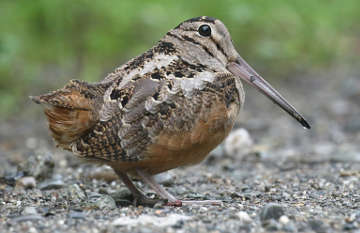

PHOTO COURTESY OF GARRY KESSLER
American woodcocks are plump, well camouflaged birds about the size of a mourning dove but heavier.
March 24, 2017, Page B7
NATURE NOTES
By Annie Reid
Westborough Community Land Trust
Sky-dancing Woodcocks
Remember bug zappers? Or the distinctive “bzzzzt” made by these insect-killing devices (now less popular than they once were)?
You might hear an odd noise that reminds you of a bug zapper if you walk near an old field or woodland clearing at dusk on a spring evening. But it’s a bird, not a bug zapper – a male American woodcock (Scolopax minor). He’s getting ready to do his famous “sky dance.” His bug-zapper call, often described as a buzzy “peent,” is one of the sounds associated with his dramatic courtship display in the air.
After several “peent” calls, the male woodcock launches himself upward, circling into the sky perhaps as high as 300 feet, with his wings making a soft whirring sound. The first three feathers on the tips of his wings are stiff, narrow, and well specialized to make this sound. Then he plunges down in a zigzag pattern, twittering as he goes. He often plops back down in the same spot, or perhaps near a waiting female.
We humans can best see these displays on a bright moonlit night, ideally under a full moon. You might hear the sounds – peents, whirring, and twitters – even if you don’t spot the bird making them.
Even in daytime, woodcocks are hard to see because they are extremely well camouflaged among dead leaves and dry grasses on the ground. A woodcock can remain still and unseen until you almost step on it. With eyes placed far back on the sides of their head, woodcocks watch behind them as well as in front and above for predators such as foxes, raccoons, hawks, and owls.
Male woodcocks typically do their sky dance from late March through early May, starting when they return to our area to breed after wintering in southern states. Males keep on displaying because they typically mate with several females, and females may also mate with more than one male. Females alone do the job of making a shallow ground nest and tending eggs and an average of four chicks, which are downy and ready to walk just a few hours after hatching.
The timing of the woodcocks’ return to our area depends on the weather because earthworms are their main food – not easy to find in frozen or snow-covered ground, such as we’ve had recently. Unlike robins, woodcocks search for earthworms in woods and fields, but not usually on our lawns.
Woodcocks’ long beaks are specialized for probing deep into moist ground and pulling up earthworms. We tend to think of birds’ beaks as hard and stiff, but woodcocks can actually bend the end of their upper beak to grab worms underground with a pincer-like movement. The end of the beak also contains sensors that help woodcocks feel movement underground. Shorebird relatives of the woodcock, such as certain sandpipers, are similarly equipped for probing muddy shores.
Woodcocks are well known as game birds, although they are not as popular with hunters as they were decades ago. Conservation studies suggest that hunting is not currently a threat to woodcock populations, which are declining in our area mainly due to habitat loss. Woodcocks need old fields, shrubby areas, wetlands, and relatively young forests, but in Massachusetts and elsewhere many of these areas are becoming mature forests or being developed.
If you’d like to try to see the woodcock’s sky dance, check for local woodcock walks on the web sites of organizations such as Mass Audubon’s Broad Meadow Brook sanctuary or the Forbush Bird Club. (For a short video of a male calling: https://www.youtube.com/watch?v=mKM0P9gWx7k.)